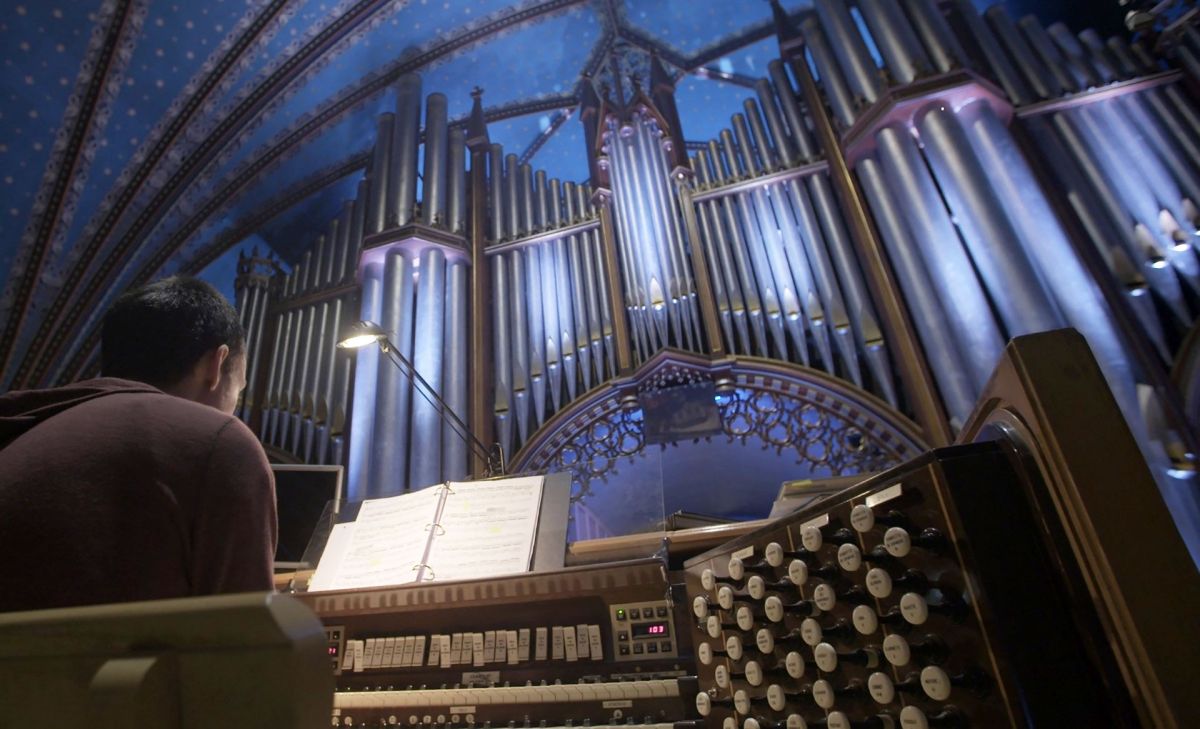By Ade D. Adeniji
Stacy Tenenbaum’s film Pipe Dreams features four young organ players competing in the prestigious Canadian International Organ Competition, held every few years in Montreal. What’s striking is that each musician has a completely different approach to playing the quirky instrument; Nick Capozzoli is all about playing obscure modern music, whereas Alcee Chriss III draws upon his gospel and jazz roots—turning our notion of the solemn instrument often found in churches on its head.
The pipe organ has origins that date back to ancient Greece and Rome, while the unusual glass harmonica dates back to Colonial Era America, but there are plenty of more modern quirky instruments that can share a place alongside them. Join us for a look under the hood of the organ, as well as other eclectically zany instruments us humans have crafted through the years, with this six-instrument primer.
Pipe Organ
The earliest pipe organs can be traced back to ancient Greece. Inventor Ctesibius of Alexandria’s instrument was driven by a hydraulics mechanism, where the air supply was maintained through water pressure – cracking the riddle of how one person could play more than one wind instrument at a time. A few centuries later, organs began to be blown by bellows, an apparatus by which the air is collected, compressed, and propelled through the channels of an organ for redistribution among the pipes.
Today, conventional pipe organs consist of four main parts: keyboard(s) and other controls, pipes to produce the tone, a device to supply wind under pressure, and a mechanism connected to the keys for admitting wind to the pipes. Organs usually possess several sets of pipes (also known as stops, or registers), playable from several keyboards and a pedalboard. Under their control are various ranks of wooden and metal pipes of different lengths and shapes.
The Glass Harmonica
The inventor of the lightning rod and bifocals, Founding Father Benjamin Franklin also created the mechanical glass harmonica—or armonica— in the 1700s. A series of glass bowls rotates while the musician touches the bowls with wet fingers to create the desired notes. And because of its unique design, multiple notes can be played at once. The likes of Mozart and Beethoven arranged pieces to include the glass harmonica, and though the instrument is far from its heyday, maybe this is just the thing to kick of a quarantine-era dance party.
Gameleste
How about an instrument that isn’t hundreds or even thousands of years old? Icelandic artist Björk commissioned the creation of new instruments for her 2011 album Biophilia, including one known as the gameleste — the work of the British percussionist Matt Nolan and the Icelandic organ craftsman Björgvin Tómasson. Nolan takes us behind the scenes of how he created it in what took about 385 man-hours total. The gameleste combines the gamelan, a traditional ensemble of Indonesia that uses bronze percussion instruments, with the celeste, an orchestral percussion instrument resembling a small upright piano.
The Great Stalacpipe Organ
Woe unto anyone who confuses the stalactite with the stalagmite. In this case, the Great Stalacpipe Organ of Luray Caverns, Virginia takes advantage of the natural sounds produced by stalactites. In the 1950s, Pentagon quant Leland W. Sprinkle tested over 3,000 stalactites, and selected around 40, shaving them down to the perfect pitch.
When pressing a key on the organ, an electrical pulse is created which directs a rubber-tipped mallet to tap a stalactite. The sound then vibrates off the cavernous walls through a whopping space of about 3.5 acres. Since stalactites constantly grow through water accumulation and are affected by weathering, the instrument also needs to be continuously tuned and refined.
Theremin
This is a device that looks like something millennials like me might’ve seen in the first few years of our life, as if an old-timey radio that would’ve sat in the same room as a rotary phone. But the theremin is an electronic musical instrument created in 1920 in the Soviet Union by Leon Theremin, an inventor and KGB spy. Notable for its whooping and sliding high-pitched squeal, the instrument consists of a box with radio tubes producing oscillations above the range of hearing. Together, they produce a lower audible frequency equal to the difference in their rates of vibration. Pitch is controlled by moving a baton or hand away or toward an antenna at the right rear of the box.
The theremin was the first electronic instrument to be mass-produced, and was used in the soundtracks of several sci-fi films, as well as front and center in the Beach Boys’ “Good Vibrations,” and it works pretty well in original Star Trek theme music (even if that wasn’t actually used in the theme itself).
The Zeusaphone
Hopefully, you still have your mnemonic for naming the Greek gods. The Zeusaphone works off of so-called musical lightning and is made up of “singing” Tesla coils. With the help of a constant current to create a magnetic field, the build-up of energy through controlled and timed surges, and air heated by plasma, high voltage sparks are discharged from a Tesla coil. Hence, the vaunted “lightning.” As each spark moves through the air, it creates atypical square waves instead of the typical, and smoother sounding, curved sine or cosine waves.
Ade Adeniji is a Staff Writer for Inside Philanthropy and an approved Rotten Tomatoes critic. He’s also written for outlets like Mic, and The Rumpus, and blogs about film, television, and the majestic NBA on his own website, adeadeniji.com. He holds degrees from Pomona College and American Film Institute Conservatory.

